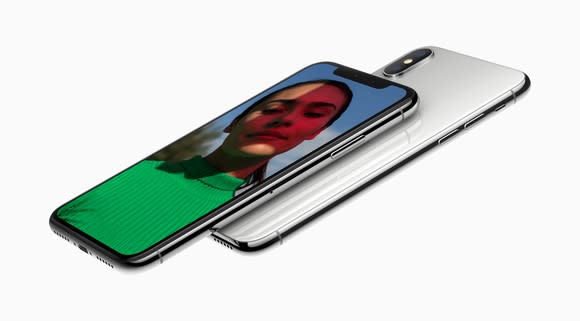How Apple Can Mitigate Risk of iPhone XR Cannibalizing the XS
On Sept. 12, Apple (NASDAQ: AAPL) unveiled its new iPhone lineup, which consists of three devices: the iPhone XR, iPhone XS, and iPhone XS Max. The iPhone XS and iPhone XS Max are the premium products in the lineup, starting at $999 and $1,099, respectively. The iPhone XS has a 5.8-inch OLED (organic light-emitting diode) screen while its larger counterpart has a 6.5-inch OLED display.
The iPhone XR -- the most affordable product in the 2018 lineup -- starts at $749 and has a 6.1-inch LCD (liquid crystal display). LCDs are cheaper to make than OLED screens.

Image source: Apple.
As my Foolish colleague Evan Niu observes, the iPhone XR could cannibalize sales of the iPhone XS. Here's Niu:
iPhone XR looks like a very compelling product, priced at a much more affordable $750 and offered in a greater range of colors for more personalization. While its specs aren't as strong as those of the XS on paper, the iPhone XR does get many of the same headline features as the flagship, including Face ID, an edge-to-edge display with no home button, and the same A12 Bionic chip inside.
For many average consumers that don't care about or can't discern the differences -- like LCD vs. OLED, lower pixel density, single-camera instead of dual-camera, among others -- the XR could be a viable alternative at $250 less. To the extent that iPhone XR demand exceeds expectations, that could mitigate the potential for gains in ASP.
His concerns seem to be justified. Analyst Ming-Chi Kuo of TF International Securities recently reported that the iPhone XS is seeing "lower-than-expected" pre-orders. In response, he went on to revise his predictions around the relative shipment mix of each of these new iPhone models:
Device | Prior iPhone Shipment Mix Forecast | Revised iPhone Shipment Mix Forecast |
|---|---|---|
iPhone XS | 15%-20% | 10%-15% |
iPhone XS Max | 25%-30% | 25%-30% |
iPhone XR | 50%-55% | 55%-60% |
Data source: Ming-Chi Kuo via MacRumors.
Kuo's revised estimates have the iPhone XR as far and away the most popular model, and the iPhone XS the least popular.
Here's how Apple might be able to shift customers away from the lowest-cost model and toward the higher-end versions in next year's product cycle.
A bigger screen
There's been a clear shift in customer preferences to larger-screen devices. In fact, it's quite telling that the iPhone XR -- the phone that Apple's targeting at the masses -- sports a 6.1-inch screen. While the 5.8-inch screen on the iPhone XS is more advanced than the one found on the iPhone XR, it's still smaller.
If Apple wants to improve the value proposition of the successor to the iPhone XS relative to the inevitable successor to the iPhone XR, it may want to consider increasing the former's screen size to match the XR's.
By endowing the successors to both the iPhone XR and iPhone XS with similarly sized screens, a bigger screen would no longer be a selling point for the iPhone XR over the iPhone XS.
Now, there may be customers who prefer the smaller 5.8-inch screen of the iPhone XS to the 6.1-inch one on the iPhone XR. To solve that problem, Apple may want to consider broadening its future high-end iPhone lineup to include three models instead of two. In fact, that's exactly what Kuo says that Samsung (NASDAQOTH: SSNLF), Apple's key rival in the premium smartphone market, will do with its Galaxy S10 devices, which he says will come in 5.8-inch, 6.1-inch, and 6.4-inch screen sizes.
A faster screen
One of the features that I really want to see Apple bring to future iPhones is the company's ProMotion display technology. In a ProMotion display, the screen refreshes its contents 120 times per second -- twice as fast as current iPhone screens.
In the next product cycle, another way Apple could differentiate the successors to the iPhone XS and iPhone XS Max from the successor to the iPhone XR would be to endow the first two devices with ProMotion screens, while leaving that feature out of the latter.
A speedier screen is something that Apple can easily market. And customers could easily see the difference if they used devices with and without ProMotion screen technology side by side.
More From The Motley Fool
Ashraf Eassa has no position in any of the stocks mentioned. The Motley Fool owns shares of and recommends Apple. The Motley Fool has the following options: long January 2020 $150 calls on Apple and short January 2020 $155 calls on Apple. The Motley Fool has a disclosure policy.
